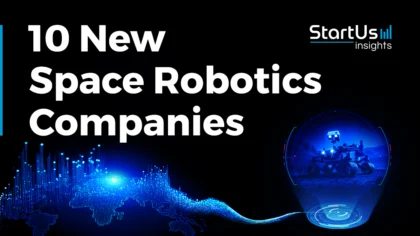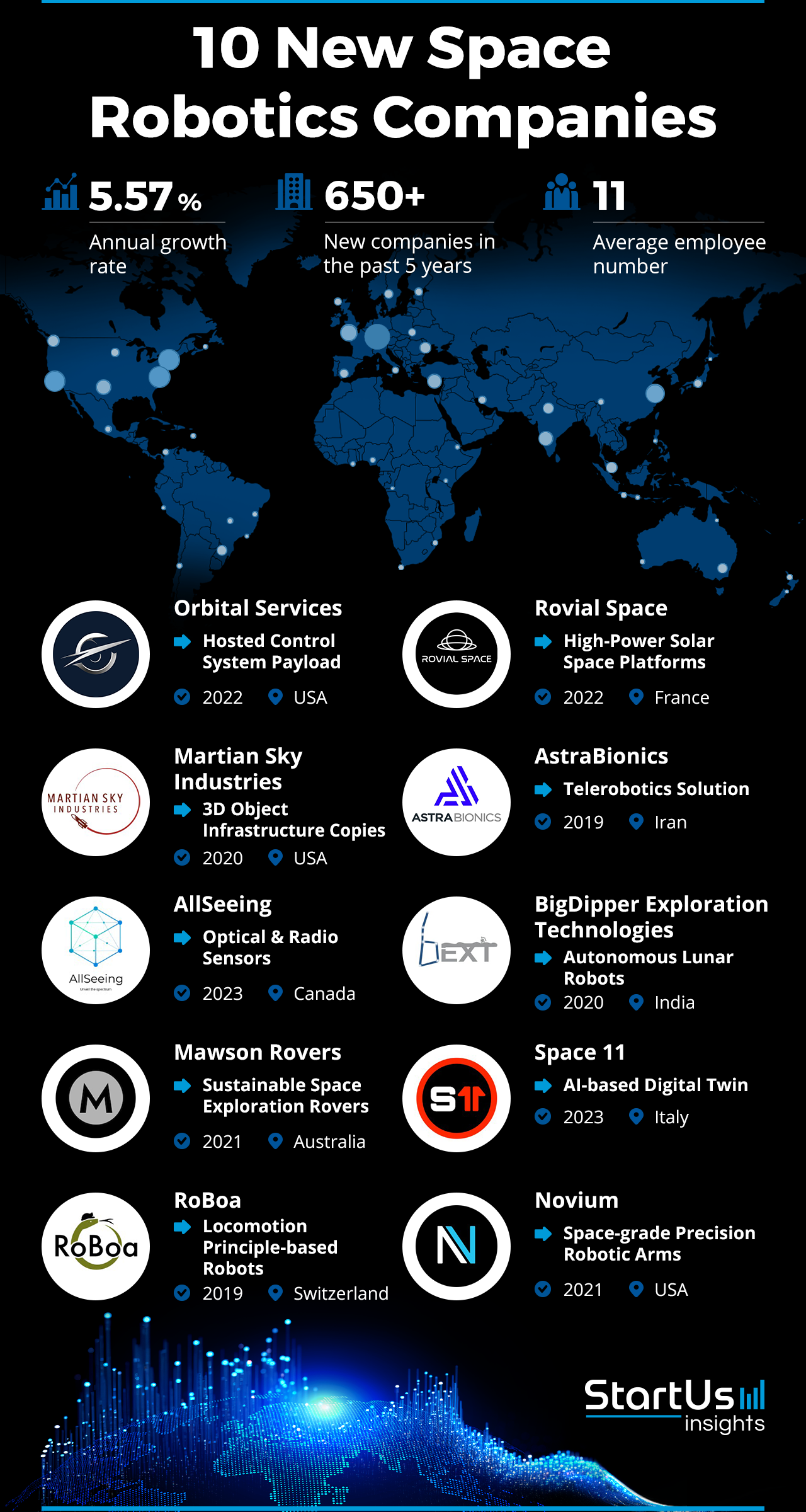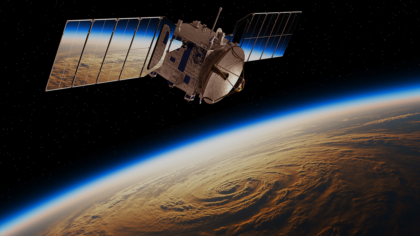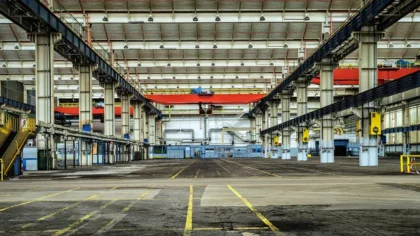This article provides an analysis of 10 new space robotics companies that drive advancements through technologies and specialized applications. These companies develop solutions such as hosted control system payloads, 3D object reconstruction, optical and radio sensors, and more. Each featured company contributes to the space robotics field, highlighting diverse applications in areas such as orbital maintenance, satellite servicing, and space manufacturing. We updated this report 5 days ago. Notice something’s off? Let’s make it right together — reach out!
Continue reading to gain up-to-date and data-driven insights on:
Key Takeaways
Drawing insights from the Big Data & AI-powered StartUs Insights Discovery Platform that provides data on over 4.7+ million emerging companies globally, we explore the evolving landscape of the space robotics industry. This sector is marked by key trends and a substantial workforce, shaping its future. Here are some key insights at a glance:
- Latest Space Robotics Trends: The latest space robotics trends include humanoid robots, lidar, motion planning, control algorithms, and biorobotics.
- Space Robotics Industry Stats: The global space robotics industry encompasses 3.5K+ organizations and has a massive 13.2K workforce. It is experiencing an increase of 5.57% in annual growth rate but has seen the emergence of 650+ new space robotics companies in the past five years. Each of these companies employs about 11 people.
- 10 New Space Robotics Solutions to Watch:
- Orbital Services – Hosted Control System Payload
- Martian Sky Industries – 3D Object Infrastructure Copies
- AllSeeing – Optical & Radio Sensors
- Mawson Rovers – Sustainable Space Exploration Rovers
- RoBoa – Locomotion Principle-based Robots
- Rovial Space – High-Power Solar Space Platforms
- AstraBionics – Telerobotics Solution
- BigDipper Exploration Technologies – Autonomous Lunar Robots
- Space 11 – AI-based Digital Twin
- Novium – Space-grade Precision Robotic Arms
Discover 10 out of 650+ Emerging Space Robotics Companies
In this section, we highlight 10 new space robotics solutions providing solutions in areas like locomotion principle-based robots, high-power solar space platforms, telerobotics bots, and more. These space robotics solutions leverage technologies like advanced robotics, AI, and sensor technologies to enhance operational efficiency, reliability, and autonomy in space missions. Read on to discover such solutions these companies provide to drive progress and expand capabilities in the space robotics industry.
Note on Signal Strength
One of the unique metrics we feature for each company is Signal Strength, a proprietary data point generated by our Discovery Platform. It gauges the extent to which a company’s influence has permeated the global ecosystem of startups, scaleups, and emerging companies. This proprietary metric serves as a valuable guidepost for understanding a company’s standing in the broader market landscape.
1. Orbital Services
- Founding Year: 2022
- Employee Range: 2-10
- Location: USA
- Signal Strength: Strong
- What they do: Orbital Services builds autonomous defensive spacecraft command and control (C2) capabilities. The company’s hosted control system payload features autonomous guidance, navigation, and control (GNC) for modeling. It utilizes low size, weight, power, and cost (SWaP-C) light detection and ranging (LiDAR) and vehicle imaging system camera (VISCAM) sensors for optical navigation and 3D imaging. This system combines neural networks and localized space domain awareness (SDA) sensor data fusion to automate kill chains for space battle management. This protects national security and commercial space assets from orbital threats.
2. Martian Sky Industries
- Founding Year: 2020
- Employee Range: 2-10
- Location: USA
- Signal Strength: Strong
- What they do: Martian Sky Industries uses computer vision, machine learning, data generation, robotics, and mission simulations to offer satellite servicing solutions. For instance, the company uses sensors to create digital 3D object copies for machine learning and simulation applications. It also offers a space-flight mission simulation to lower the risk and cost of space hardware testing. While the company’s LiDAR technology gathers distance data remotely, its computer vision techniques distinguish between space objects to inform downstream decision-making.
3. AllSeeing
- Founding Year: 2023
- Employee Range: 2-10
- Location: Canada
- Signal Strength: Medium
- What they do: AllSeeing provides optical and radio sensors that aid spectrum and spatial awareness. Its proximity awareness sensor, PAWS, is a software-defined, high-resolution imaging radar that supports space operations. PAWS transmits radio waves across its 180° fish-eye field of view (FOV) to measure backscatter properties and generate 3D images in the radio spectrum. The antenna design provides high-resolution images while detailing velocity, dielectric properties, and material type of objects. It is immune to optical and radio interference and, hence, works in dynamic environments. PAWS operates autonomously with millimeter resolution and dense antenna elements for high accuracy and reliability without human interaction.
4. Mawson Rovers
- Founding Year: 2021
- Employee Range: 2-10
- Location: Australia
- Signal Strength: Medium
- What they do: Mawson Rovers builds robotic vehicles for sustainable space exploration. Its R1 rover is a 20 kg-class vehicle that works as a terrestrial demonstrator for rover development. This vehicle tests mobility on Earth and develops sensors and actuators for future lunar applications. The company also offers custom hardware and software for space systems. In this way, the company contributes to lunar facilities and infrastructure construction, maintenance, and inspection operations.
5. RoBoa
- Founding Year: 2019
- Employee Range: 2-10
- Location: Switzerland
- Signal Strength: Medium
- What they do: RoBoa utilizes a growing-based locomotion principle to build robots. The robot extends up to 100 meters in length and has a 5-10 cm diameter for navigating tight spaces and hazardous environments. RoBoa’s pneumatic operation ensures safety in explosive areas while its soft design prevents damage to delicate surfaces. With a modular actuator system, the robot features 3D steering to enable efficient maneuverability. Its sensor configurations, including cameras, microphones, and time-of-flight sensors, support inspection, monitoring, and mapping tasks.
6. Rovial Space
- Founding Year: 2022
- Employee Range: 11-50
- Location: France
- Signal Strength: Strong
- What they do: Rovial Space leverages AI-enabled robotics to build high-power solar space platforms. It utilizes large mass SpaceX rockets to assemble proprietary robots and maintain these platforms. They support diverse payloads within the launcher. Rovial Breakthrough platform provides power outputs from 100 kW to 500 kW and enables applications such as high-power communications, space data centers, space lasers, and power beaming. Additionally, Rovial Space’s adaptable robots perform in-space satellite inspections, maintenance, and repair.
7. AstraBionics
- Founding Year: 2019
- Employee Range: 11-50
- Location: Iran
- Signal Strength: Medium Strong
- What they do: AstraBionics develops Astra-Bot using telerobotics. It includes sensors, manipulators, and communication systems to enable remote operation by astronauts or ground-based operators. These remotely-controlled robots mitigate risks associated with human spaceflight to ensure safe and efficient operations in space. Further, it facilitates maintenance, repairs, and scientific experiments on spacecraft, space stations, and planetary surfaces.
8. BigDipper Exploration Technologies
- Founding Year: 2020
- Employee Range: 2-10
- Location: India
- Signal Strength: Very Strong
- What they do: BigDipper Exploration Technologies offers modular and autonomous robots to collect lunar surface data and explore lunar resources. The robots identify and excavate resources, like water ice, vital for sustainable space presence. They also feature solar-electric power, modular design, and swarm intelligence. Through these solutions, the company offers payload, data, infrastructure, and mining services on the lunar surface.
9. Space 11
- Founding Year: 2023
- Employee Range: 2-10
- Location: Italy
- Signal Strength: Medium
- What they do: Space 11 provides an AI-enabled digital twin device, MK-11, for space robotics. The device features a 40 tera operations per second (TOPS)-integrated neural processing unit (NPU) to process sensor data through convolutional neural network (CNN) models. This enhances space situational awareness and operational safety. Also, drones and aerial robots provide continuous data reporting and emergency management in autonomous space configurations.
10. Novium
- Founding Year: 2021
- Employee Range: 11-50
- Location: USA
- Signal Strength: Medium
- What they do: Novium develops modular robotic arms using precision engineering, robotics, automation, and electrification for challenging space applications. These arms assist in tasks such as satellite servicing, space debris clean-up, space station assembly, and lunar mining. Novium provides affordable solutions that also offer high accuracy and consistency.
Quick Tip to Find New Space Robotics Companies
Utilizing a SaaS platform like the Discovery Platform for identifying new space robot companies provides significant benefits compared to traditional scouting methods:
- Increased Efficiency: The Discovery Platform offers advanced tools that streamline the scouting process. It replaces your hours of conventional desk research, saving time and resources in identifying space robotics innovations.
- Access to Real-time Insights: Gain a competitive edge with up-to-date information on the latest trends in the space robotics industry. The platform keeps you informed with near real-time updates on emerging space robot companies and news, enabling you to make swift and informed decisions.
- Precise Scouting: Customize your search to focus on specific niches within the space robotics sector, such as locomotion principle-based robots, telerobotics, or autonomous lunar robots. The platform’s diverse filtering options allow you to target your scouting efforts precisely, ensuring that you find the most relevant and groundbreaking companies in the field.
Ready to Explore All New Space Robotics Companies?
We’ve explored the dynamic landscape of the space robotics industry, examining the latest trends and spotlighting exceptional companies driving innovation. To dive deeper, download our free SpaceTech Report or schedule a demo of the Discovery Platform for a customized exploration of these groundbreaking developments. We’re keen to partner with subject matter experts to enrich our coverage. Think you can help? Let us know.










